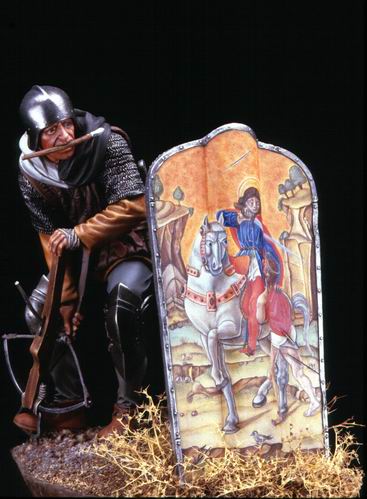Part of the effect of the longbow in battle was rate of fire - an English archer could loose anything from 15-20 arrows a minute. Records for Towton in 1461 (where both sides had archers) estimate that half a million arrows were loosed in 10 minutes
Quote:
English archers have attained a mythic status down the ages because of the showy underdog victories at Crécy and Agincourt. They were nation-specific – only the English and the Welsh took on the discipline, the plebeian odium and the round loathing that came with a bow. None of the continental countries deigned to partake, preferring to be nobly kebabbed. They relied on specialist Genoese crossbowmen – the Polish plumbers of medieval battlefields. Not even the bellicose Scots and Irish could be bothered with bows, but when used in sufficient numbers and with discipline, the longbow was the lethal arbiter of battlefields for 300 years.
It was slowly replaced by gunpowder . Any terrified peasant could point and pull a trigger, but it took a lifetime of aching, deforming practice to muscle up the 100lb of tug needed to draw a yew bow to dispatch a cloth yard of willow-shafted, goose-feathered, bodkin-tipped arrow 200 yards through plate, through chain, through leather and linen and prayers, into a man’s gizzard. The longbow was the most lethally efficient dealer of death on European battlefields until the invention of rifling and the Gatling gun.
The archers stepped forward and together chucked up what they call the “arrow storm”. An English archer could fire 15 to 20 arrows in a minute – that’s what made the opening moments of battle so horrific. The eclipse of arrows would have crossed high in the frozen air, and in that moment Edward and the House of York had their touch of luck.
The thick, stinging curtain of snow slashed the faces of the Lancastrian line, making it difficult to aim or judge distance, pushing their arrows short. And it carried the arrows of York further and deeper into the Lancastrian line. God howled and cracked for Edward that morning, searing the cheeks and freezing the eyes of Lancaster.
The metal-detectors have found the long, broad trench of bodkin points, showing where the first appalling fusillade was loosed. Emptying their own quivers, they began firing back the arrows wasted by their enemies. There may have been half a million arrows fired in 10 minutes that day – the largest longbow shafting in history http://www.timesonline.co.uk/tol/tra...ffset=0&page=1
|
Now, compare that with what thus guy is doing for most of that time

which would mainly be adding to the colour of the battlefield with his pretty pavise.....
The success of the archer in battles like Crecy, Poitiers, Agincourt & Towton was down to rate of fire & the number of arrows that could be loosed - it depended little on accuracy - basically it was like charging into a solid, but very spiky, wall. The impact would knock you over, & then you'd have virtually no chance of getting up again before you were trampled to death (usually by your own side). Yes, you can carry a crossbow loaded & cocked, but if you missed, then once your first shot was loosed an archer could put a dozen arrows into you before you could get off a second shot. Also you have the problem of weather - at Crecy there had been a sharp rainstorm just before the battle which had weakened the strings of the crossbows carried by the Genoese, whereas the English carried spare bowstrings in their helmets which were nice & dry & could re-string their bows quickly. It was the gun which put paid to the bow, not the crossbow, & it took a long time for guns to develop to the required standard of reliability & effectiveness.